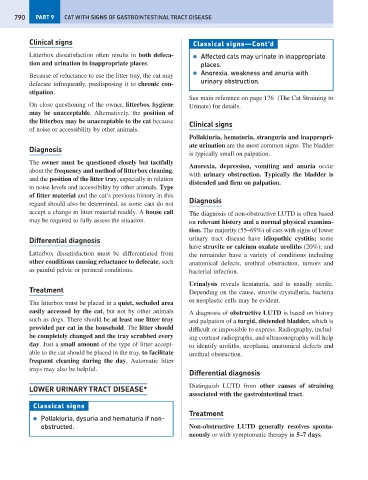Page 798 - Problem-Based Feline Medicine
P. 798
790 PART 9 CAT WITH SIGNS OF GASTROINTESTINAL TRACT DISEASE
Clinical signs Classical signs—Cont’d
Litterbox dissatisfaction often results in both defeca- ● Affected cats may urinate in inappropriate
tion and urination in inappropriate places. places.
● Anorexia, weakness and anuria with
Because of reluctance to use the litter tray, the cat may
urinary obstruction.
defecate infrequently, predisposing it to chronic con-
stipation.
See main reference on page 176 (The Cat Straining to
On close questioning of the owner, litterbox hygiene Urinate) for details.
may be unacceptable. Alternatively, the position of
the litterbox may be unacceptable to the cat because Clinical signs
of noise or accessibility by other animals.
Pollakiuria, hematuria, stranguria and inappropri-
ate urination are the most common signs. The bladder
Diagnosis
is typically small on palpation.
The owner must be questioned closely but tactfully
Anorexia, depression, vomiting and anuria occur
about the frequency and method of litterbox cleaning,
with urinary obstruction. Typically the bladder is
and the position of the litter tray, especially in relation
distended and firm on palpation.
to noise levels and accessibility by other animals. Type
of litter material and the cat’s previous history in this
regard should also be determined, as some cats do not Diagnosis
accept a change in litter material readily. A house call The diagnosis of non-obstructive LUTD is often based
may be required to fully assess the situation. on relevant history and a normal physical examina-
tion. The majority (55–69%) of cats with signs of lower
Differential diagnosis urinary tract disease have idiopathic cystitis; some
have struvite or calcium oxalate uroliths (20%); and
Litterbox dissatisfaction must be differentiated from the remainder have a variety of conditions including
other conditions causing reluctance to defecate, such anatomical defects, urethral obstruction, tumors and
as painful pelvic or perineal conditions. bacterial infection.
Urinalysis reveals hematuria, and is usually sterile.
Treatment Depending on the cause, struvite crystalluria, bacteria
The litterbox must be placed in a quiet, secluded area or neoplastic cells may be evident.
easily accessed by the cat, but not by other animals A diagnosis of obstructive LUTD is based on history
such as dogs. There should be at least one litter tray and palpation of a turgid, distended bladder, which is
provided per cat in the household. The litter should difficult or impossible to express. Radiography, includ-
be completely changed and the tray scrubbed every ing contrast radiographs, and ultrasonography will help
day. Just a small amount of the type of litter accept- to identify uroliths, neoplasia, anatomical defects and
able to the cat should be placed in the tray, to facilitate urethral obstruction.
frequent cleaning during the day. Automatic litter
trays may also be helpful.
Differential diagnosis
Distinguish LUTD from other causes of straining
LOWER URINARY TRACT DISEASE*
associated with the gastrointestinal tract.
Classical signs
Treatment
● Pollakiuria, dysuria and hematuria if non-
obstructed. Non-obstructive LUTD generally resolves sponta-
neously or with symptomatic therapy in 5–7 days.

